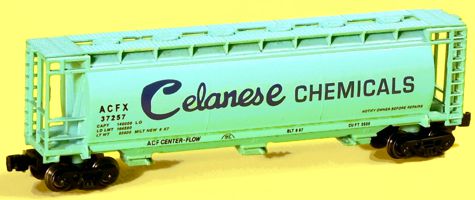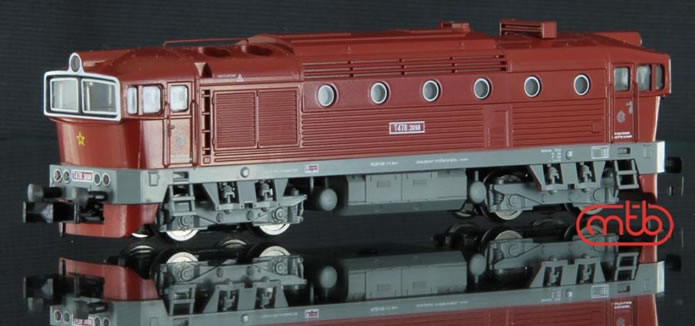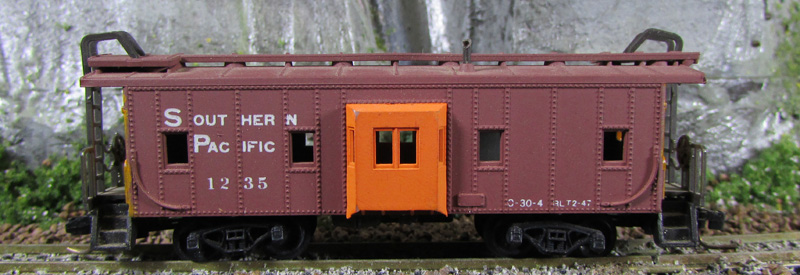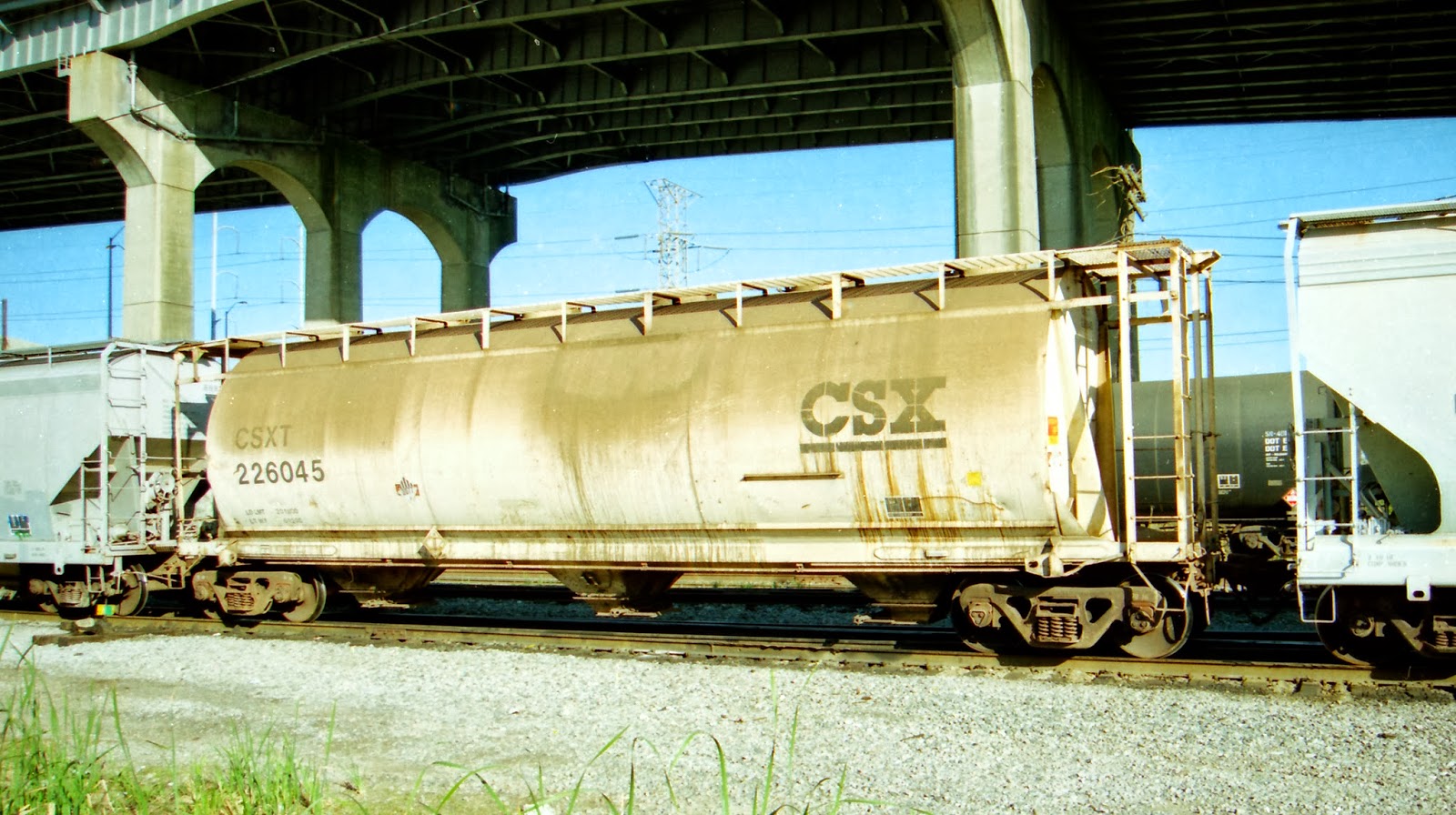Specific Item Information: Road Numbers: ACFX 37252 & 37257
Model Information: After WWII, US railroads were increasingly called upon to haul new and unique "modern" products over long distances. In response, American Car and Foundry (ACF) designed a tank-type covered hopper car. The cylindrical shape created a better weight/volume ratio; plus, the elimination of interior ledges, combined with hatches and outlets placed along a center-line, led to ACF's trademark "Center Flow" hoppers. Through the 1960s the Cylindricals became omnipresent on our nation's railroads, with many styles of hatches and outlets devised according to needs. Because the cars were compartmented, various different loads could be carried in a single unit, and some had aluminum construction to further reduce weight. Here was a "Freight Car for the Future," ready to transport sugar, cement, sand, salt, fertilizers, many types of grains, coke, starch, feeds, chemicals and plastics!
Prototype History: ACF introduced their roundish cylindrical hoppers in the early 1960s. The cars differed greatly from the ribbed sided hoppers of the era. They have been made in 3-bay and 6-bay variations. These cylindrical hoppers were superseded on ACF’s production line by the Centerflow in 1964, a revolutionary design that influenced later covered hopper types. In the late 60s or early 70s Canada came out with 4-bay covered hoppers that appear to be derived from ACF’s pre-Centerflow cylindrical hoppers. These cars were used by CN, CP and various smaller Canadian shippers. There is some question as to why the Canadian builder based their design off the older cylindrical and not ACF’s newer Centerflow. It was likely a patent issue and copying it could have triggered legal action against the Canadian builders. There are also certain structural design differences between the cylindrical and centerflow cars and perhaps the decision to copy the cylindrical was based on the greater volume capacity of the cylindrical design.
Road Name History: Celanese was founded in 1918 in New York City as the American Cellulose & Chemical Manufacturing Company, initially producing fabrics for airplane manufacturing. They adopted the name “Celanese Corporation” in 1927 and began producing synthetic cellulose acetate fabrics and yarns for textile companies.
Celanese Corporation, also known as Hoechst Celanese, is a Fortune 500 global technology and specialty materials company with its headquarters in Irving, Texas, United States. The company is a leading producer of acetyl products, which are intermediate chemicals for nearly all major industries, and is the world's largest producer of vinyl acetate monomer (VAM).
Celanese's operations are primarily located in North America, Europe, and Asia. Its largest plant is in the Clear Lake area of Pasadena, Texas, United States the home to the world's largest acetic acid plant. In 2016, Celanese reported net sales of $5.4 billion.
The American Cellulose and Chemical Manufacturing Co. Ltd plant in Cumberland, Maryland was set up during World War I to produce cheaper fabric for airplane manufacturing. The plant location was chosen inland to protect against Zeppelin attacks. It was also situated in proximity to a ready source of water at the Potomac River and easy access to coal supplies and railroad lines. After a series of delays, actual production began in 1924 with a series of cellulose acetate commercial fabrics and yarns intended as alternatives to silk. The plant was closed in 1983, and was later torn down to provide a space for a new state prison.
From Wikipedia
Celanese Corporation, also known as Hoechst Celanese, is a Fortune 500 global technology and specialty materials company with its headquarters in Irving, Texas, United States. The company is a leading producer of acetyl products, which are intermediate chemicals for nearly all major industries, and is the world's largest producer of vinyl acetate monomer (VAM).
Celanese's operations are primarily located in North America, Europe, and Asia. Its largest plant is in the Clear Lake area of Pasadena, Texas, United States the home to the world's largest acetic acid plant. In 2016, Celanese reported net sales of $5.4 billion.
The American Cellulose and Chemical Manufacturing Co. Ltd plant in Cumberland, Maryland was set up during World War I to produce cheaper fabric for airplane manufacturing. The plant location was chosen inland to protect against Zeppelin attacks. It was also situated in proximity to a ready source of water at the Potomac River and easy access to coal supplies and railroad lines. After a series of delays, actual production began in 1924 with a series of cellulose acetate commercial fabrics and yarns intended as alternatives to silk. The plant was closed in 1983, and was later torn down to provide a space for a new state prison.
From Wikipedia
Brand/Importer Information: 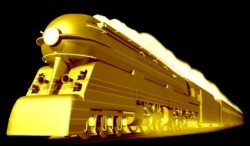 Greetings, I'm Will, a Fine Arts graduate of Kutztown University in Pennsylvania who grew up in the Delaware Valley. I worked for 30 years with the Pennsylvania German Folklife Society. For ten years I had a permanent booth, each month showing my "PA Dutch" wares, at the country's largest under-roof Antique Market in Atlanta, GA. When Mom and Dad started to have health issues, I was forced to give up the nomadic life, but during my travels I came to love Z Scale Model Railroading, as I could easily take small layouts with me to the motels and play with my trains in the evenings!
Greetings, I'm Will, a Fine Arts graduate of Kutztown University in Pennsylvania who grew up in the Delaware Valley. I worked for 30 years with the Pennsylvania German Folklife Society. For ten years I had a permanent booth, each month showing my "PA Dutch" wares, at the country's largest under-roof Antique Market in Atlanta, GA. When Mom and Dad started to have health issues, I was forced to give up the nomadic life, but during my travels I came to love Z Scale Model Railroading, as I could easily take small layouts with me to the motels and play with my trains in the evenings!
Now that Mom and Dad are gone, and after many years of providing care for my "Pappy" in Florida, I find myself a homebody in the "Sunshine State" with a neat little business, supplying interested Z hobbyists with rolling stock and unique quality products!

Item created by: CNW400 on 2021-08-11 11:04:09. Last edited by CNW400 on 2021-08-17 09:14:06
If you see errors or missing data in this entry, please feel free to log in and edit it. Anyone with a Gmail account can log in instantly.
If you see errors or missing data in this entry, please feel free to log in and edit it. Anyone with a Gmail account can log in instantly.


